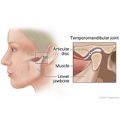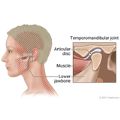Condition Basics
What are temporomandibular disorders (TMDs)?
Temporomandibular disorders (TMDs) is the name given to several problems with jaw movement and pain in and around the jaw joints. They cause pain when you talk, chew, swallow, or yawn.
You may also hear TMDs called TMJ or TM problems.
The jaw joints, or temporomandibular (TM) joints, connect the lower jawbone (mandible) to the skull. These flexible joints are used more than any other joint in the body. They allow the jaw to open and close for talking, chewing, swallowing, yawning, and other movements.
What causes them?
TMDs are caused by muscle tension, often triggered by stress. Clenching or grinding your teeth can tire the jaw muscles, leading to muscle spasms, tissue damage, pain, and sore muscles. A TMD can also start with an injury to the jaw joint or a joint disease like osteoarthritis or rheumatoid arthritis.
What are the symptoms?
TMDs can affect the jaw and jaw joint as well as muscles in the face, shoulder, head, and neck. Common symptoms include joint pain, muscle pain, headaches, joint sounds, trouble with fully opening the mouth, and jaw locking.
How are they diagnosed?
There is no one way to diagnose a TMD. Your doctor can check your condition with a physical examination and by asking questions about your health. In some cases, an X-ray, CT scan, or MRI is also used to check for bone or soft tissue problems related to symptoms of a TMD.
How are TMDs treated?
The focus of TMD treatment is to ease pain in the jaw joint and restore normal jaw movement. Initial treatment involves over-the-counter pain medicine and self-care at home. Splints can help reduce teeth grinding and clenching. Your doctor may suggest other treatments as well. Surgery isn't usually done to treat TMDs.
Health Tools
Health Tools help you make wise health decisions or take action to improve your health.
Prevention
To prevent temporomandibular disorders (TMDs), try to reduce muscle tension in your jaw. Here are some ways you can reduce muscle tension.
- Relax.
If you have a lot of stress and anxiety in your life, try relaxation techniques.
- Learn to recognize when you are clenching your teeth.
- Practice keeping your teeth apart, bringing them together only when swallowing or eating.
- When driving, avoid clenching the wheel with both hands, because often your teeth will be clenched also.
- Do not overuse and stress your jaw muscles.
Avoid constantly chewing gum, biting your nails, or resting your chin on your hand.
- Change your diet.
- Eat softer foods, and use both sides of your mouth to chew your food.
- Avoid hard or chewy foods, such as popcorn, apples, carrots, taffy, hard breads, and bagels.
- Maintain good posture.
Poor posture may disturb the natural alignment of your facial bones and muscles, causing pain.
In the past, various procedures such as dental restoration and orthodontic treatment were used to prevent joint sounds from developing into TMDs. Such measures are not only unneeded but also potentially damaging to a joint that may never become painful on its own.
Explore more
Symptoms
TMDs can affect the jaw and jaw joint as well as muscles in the face, shoulder, head, and neck. Common symptoms include joint pain when you move your jaw. You may have pain when you open your mouth widely, chew, or yawn. Other symptoms include muscle pain, headaches, joint sounds like clicking and popping, trouble with fully opening the mouth, and jaw locking. Sometimes pain around the ear, with pressure or ringing in the ears (tinnitus), develops with TMDs.
In most cases, symptoms of a TMD are mild and don't last long. They tend to come and go without getting worse and usually go away without a doctor's care.
Some people who have a TMD develop long-lasting (chronic) symptoms. Chronic pain or trouble moving the jaw may affect talking, eating, and swallowing. This may affect a person's overall sense of well-being.
What Happens
The course of TMDs caused by muscle tension varies depending on the reason for the tension.
- If muscle tension is related to a one-time overuse injury (such as holding your mouth open for a long time during a dental exam), the pain may go away without treatment.
- If there is long-lasting (chronic) muscle tension due to stress, a jaw injury, or habits like grinding the teeth during sleep, treatment may relieve pain and discomfort. If chronic muscle tension isn't treated, it may gradually cause changes in the joint structure or osteoarthritis.
TMDs caused by problems in the structure of the jaw joint may:
- Respond well to treatment, if treated early.
- Get worse, if not treated. Long-term problems include injury to the joint, arthritis, or chronic pain.
In some cases, TMDs can be extremely painful and last a long time. In these cases, it's important to seek treatment.
Examinations and Tests
There is no one way to diagnose a TMD. Your doctor can check your condition with a physical examination and by asking questions about your past health.
If you have sudden pain after a facial or jaw injury, your doctor may also order some type of imaging test. This may be an X-ray, a CT scan, or an MRI.
Regardless of cause, if you still have symptoms after the first period of treatment, your doctor may look for problems in the jaw joint structure. Tests may include:
- X-ray.
-
This test can confirm whether the bones are worn away, broken, or disfigured.
- MRI.
-
This test can show soft tissues (ligaments, muscles, and articular disc) that may be involved with disc displacement or damage.
Treatment Overview
The focus of treatment of TMDs is to ease pain in the jaw joint and restore normal jaw movement. Over-the-counter pain medicine and self-care that you can do at home work well. Using techniques to relax your muscles and manage stress can also help.
Dental splints are a common treatment for TMDs. Splints are usually pieces of plastic that fit between the upper and lower teeth. They help reduce grinding and clenching.
Your doctor may suggest physiotherapy if your symptoms are related to muscle tension. This treatment can help you stretch and release tight muscles and scar tissue.
Your doctor may prescribe medicines. These may include non-steroidal anti-inflammatory drugs (NSAIDs), muscle relaxants, or tricyclic antidepressants. In some cases, a doctor may inject numbing medicine into the spot that hurts.
Most people don't need permanent dental work or surgery. But surgery may be used if you have severe structural problems in your jaw joint.
Learn more
Self-Care
- Put either an ice pack or a warm, moist cloth on your jaw for 15 minutes several times a day. You can try switching back and forth between moist heat and cold.
- Make eating easy on your jaw. Choose softer foods that are easy to chew like eggs, yogurt, or soup. Avoid hard foods that cause your jaws to work very hard. Try cutting your food into small pieces. And if your jaw gets too painful to chew, or if it locks, you may need to puree your food for a while.
- To relax your jaw, repeat this exercise for a few minutes every morning and evening. Watch yourself in a mirror. Gently open and close your mouth. Move your jaw straight up and down. But don't do this if it makes your pain worse.
- Manage stress. You may be clenching or tightening your muscles when you are under stress.
- Get at least 2½ hours of moderate to vigorous exercise a week to relieve stress. Walking is a good choice.
- Ask your doctor if you can take an over-the-counter pain medicine, such as acetaminophen (Tylenol), ibuprofen (Advil, Motrin), or naproxen (Aleve). Be safe with medicines. Read and follow all instructions on the label.
- Use good posture for sitting and standing. Slumping your shoulders disturbs the alignment of your facial bones and muscles.
- Don't:
- Hold a phone between your shoulder and your jaw.
- Open your mouth all the way, like when you sing loudly or yawn.
- Clench or grind your teeth, bite your lips, or chew your fingernails.
- Clench things such as pens, pipes, or cigars between your teeth.
Learn more
Related Information
Credits
Current as of: November 14, 2022
Author: Healthwise Staff
Medical Review:
Adam Husney MD - Family Medicine
Martin J. Gabica MD - Family Medicine
Kathleen Romito MD - Family Medicine
Current as of: November 14, 2022
Author: Healthwise Staff
Medical Review:Adam Husney MD - Family Medicine & Martin J. Gabica MD - Family Medicine & Kathleen Romito MD - Family Medicine



